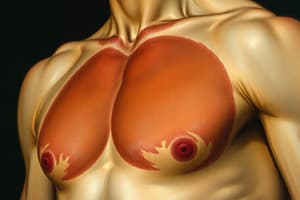Podcast
Questions and Answers
In cutaneous respiration, how does gas exchange occur?
In cutaneous respiration, how does gas exchange occur?
- Through gills or lungs
- Via the digestive system
- By diffusion through the bloodstream
- Across the skin or outer integument of an organism (correct)
How does cutaneous respiration occur?
How does cutaneous respiration occur?
- Via active transport mechanisms
- By direct diffusion from the environment
- By way of countercurrent exchange (correct)
- Through concurrent exchange
Which of the following animals exhibits cutaneous respiration?
Which of the following animals exhibits cutaneous respiration?
- Reptile
- Bird
- Amphibian (correct)
- Fish
What is an advantage of cutaneous respiration?
What is an advantage of cutaneous respiration?
How do environmental changes affect cutaneous respiration?
How do environmental changes affect cutaneous respiration?
Why do animals relying on cutaneous respiration not need specialized respiratory structures?
Why do animals relying on cutaneous respiration not need specialized respiratory structures?
Flashcards are hidden until you start studying
Study Notes
Cutaneous Respiration
- Gas exchange occurs through the skin, allowing for the exchange of oxygen and carbon dioxide directly between the environment and the body's internal tissues.
Characteristics of Cutaneous Respiration
- Cutaneous respiration occurs in animals that have a moist, permeable skin that allows for the exchange of gases.
Examples of Cutaneous Respiration
- Amphibians, such as frogs and toads, exhibit cutaneous respiration.
Advantages of Cutaneous Respiration
- An advantage of cutaneous respiration is that it allows for the exchange of gases without the need for specialized respiratory structures, such as lungs.
Environmental Factors Affecting Cutaneous Respiration
- Environmental changes, such as changes in temperature, humidity, and oxygen levels, can affect the rate of cutaneous respiration.
Evolutionary Adaptations
- Animals relying on cutaneous respiration do not need specialized respiratory structures because their skin is adapted to facilitate gas exchange.
Studying That Suits You
Use AI to generate personalized quizzes and flashcards to suit your learning preferences.




